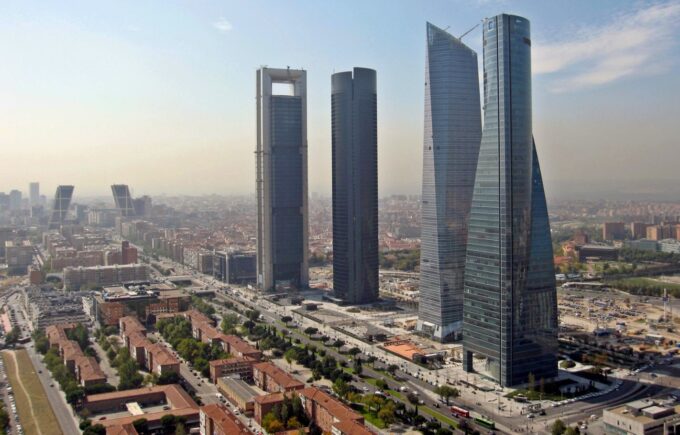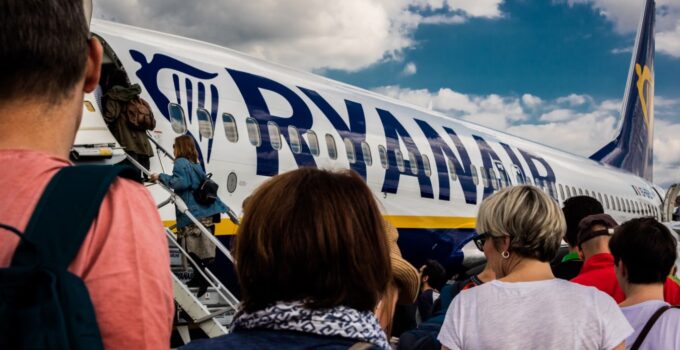Love them or hate them, Ryanair is a massive airline company with a huge tie to Spain. They’re like marmite. If you’re watching their TikTok at the minute, you’ll probably love them. Their marketing team has it on point.
And where do they like flying to the most? Apart from Ireland, Spain is one of the most-flown countries by Ryanair.
And recently, your favourite (or not favourite) airline announced it wanted to open five new bases in Spain and increase its growth in the country by 40%.
Read on to learn what that means for Ryanair, passengers, and Spain.
Establishing New Bases

Spain is one of the most-visited countries in Europe by tourists. And, of course, Ryanair wants to make money from that. In fact, they want to make money from anything. In one interview, Ryanair boss, Michael O’Leary, said he’d sell standing-up seats for one euro and that those tickets would sell out first.
And he’s not wrong. A one euro flight to Spain and standing for 2 hours? Perfect. Turbulence and standing? Maybe not. If you have a look at flights online from Spain to the UK, they’re cheap enough not to need to stand.
Anyway, Ryanair’s vision is to open five new bases across Spain. It’s a strategic move poised to bolster its operational footprint significantly. This expansion is not just about adding new destinations. It’s about weaving Ryanair’s presence into Spain’s regional connectivity. Well, it has already done that. It’s the leading airline to fly to Spain.
By growing its base network, Ryanair is set to offer more choices to passengers, create competition, and stimulate local economies. Apparently, it’ll be good for everyone. Even passengers.
A Surge in Passenger Traffic
The ambitious goal (and it is ambitious) is to increase passenger numbers from 55 million to 77 million by 2030. The surge in passenger traffic is expected to be a catalyst for economic growth – but we can guarantee it won’t all be smooth sailing. If you’ve experienced a Ryanair delay before, you’ll know what we mean.
Still, it should drive the tourism sector, create jobs, and invigorate ancillary industries.
Here are some of the top locations in Spain that Ryanair already flies to:
- Alicante
- Tenerife
- Seville
- Murcia
- Valencia
It actually pretty much covers all areas.
Navigating Economic Avenues

Source: en.wikipedia.org
Ryanair’s decision to invest in Spain has been influenced by a conducive economic environment and the assurance of stable airport charges until 2026-2027. But come on, it’s Spain, and the Spanish bureaucracy isn’t always good. The clarity (hopefully) on charges and Ryanair’s call for competitive incentives in various Spanish regions underlines the airline’s strategic approach to fostering a mutually beneficial relationship with the country.
Collaborations with the government (not always smooth), as seen in the discussions between Ryanair’s CEO and Spain’s President, Pedro Sánchez, highlight a shared vision to strengthen regional airports. And some of them do need strengthening. They’re already trying to do it with the likes of the new Murcia airport.
Enriching the Route Map
The plan to enrich Ryanair’s route map in Spain from 730 to over a thousand by 2030 shows the airline’s ambition to redefine air connectivity in the country – and to be honest, another 300 will bring Spain a lot of money. And let’s not forget the passengers – the passengers will have unprecedented travel options. But again, how many of the flights do you think will be on time? We hear compensation bells calling.
With the addition of 33 new aircraft and the establishment of five new bases, Ryanair’s investment is poised to paint the Spanish skies. The 33 new aircraft could finally solve the Ryanair delay issue – but we doubt it. Still, for the cheap flights, we’ll take it.
Fostering Sustainable Mobility
Investments are evaluated on economic merit and their environmental footprint. Ryanair’s investment strategy is aligned with the government’s vision for sustainable mobility. It was the perfect idea. By focusing on strengthening regional airports and enhancing air traffic, the investment plan is not just about expanding Ryanair’s operations. It’s about propelling Spain towards a future where economic growth and environmental stewardship go hand in hand. But they must manage it well. There’s already enough traffic in the sky.
Ryanair’s €5B investment in Spain is an exciting initiative with far-reaching implications – if it works. The growth, collaboration, and foresight should merge with the aspirations of a leading airline with the developmental goals of a nation.
As Ryanair embarks on this ambitious journey, its investment is set to be a cornerstone in Spain’s aviation story. It promises an era marked by connectivity, economic growth, and a commitment to sustainable progress.
Boosting Employment and Training Opportunities

Source: euronews.com
With Ryanair’s extensive investment in Spain, a significant boost in employment opportunities is on the horizon. The establishment of new bases and the introduction of new routes necessitate a larger workforce, including pilots, cabin crew, ground staff, and administrative personnel. This expansion is not merely about increasing numbers; it’s about enhancing the skill set within the aviation sector in Spain. Ryanair’s investment could potentially lead to comprehensive training programs, upskilling initiatives, and partnerships with local educational institutions. These efforts aim to equip the local workforce with the necessary skills to thrive in a dynamic aviation environment, thereby contributing to the overall development of the industry in Spain.
Stimulating Local Economies
Ryanair’s €5B investment is expected to have a ripple effect on local economies across Spain. By increasing the number of flights and destinations, Ryanair will bring more tourists to various regions, not just the popular coastal areas. This influx of visitors is likely to boost demand for local services and products, from hospitality and retail to cultural and leisure activities. Furthermore, the establishment of new bases will encourage infrastructure development, such as improved transportation links and airport facilities. This development is anticipated to attract further investment, not only in the tourism sector but also in other industries, thereby fostering economic diversification and resilience in local communities.







